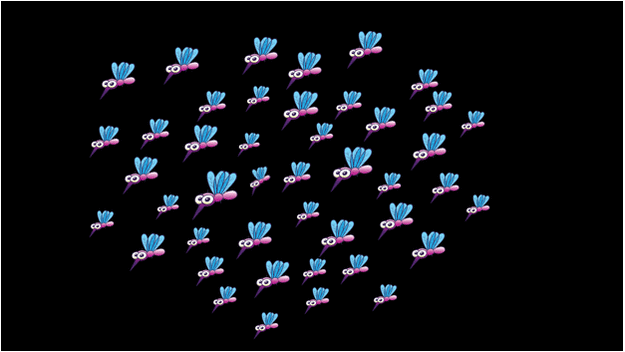In Brief:
- Mosquito-borne diseases – Zika virus, dengue fever, yellow fever, and chikungunya – affect hundreds of millions of people each year
- Genetically modified mosquitoes can reduce Aedes aegypti population by up to 90%
- These self-limiting mosquitos have incited protest against Oxitec, the biotech company that created them
“Bug off!” is something most people would say to a pesky mosquito. But in the wake of the Zika virus, mosquitoes have gone from mildly annoying to mildly terrifying. One species of mosquito, Aedes aegypti, commonly carries diseases such as dengue, Zika, chikungunya, and yellow fever. Zika, emerging recently, has reached Florida, and is known to cause serious birth defects such as microcephaly. To fight this, one company has created genetically modified mosquitoes that decrease their own population to limit the spread of disease.
Diseases such as dengue fever are debilitating or even fatal, with no cure or vaccine in sight, and there are more than 390 million dengue infections per year. The best way to fight these mosquito-borne diseases is to prevent mosquito bites. This can be done through bug sprays, long clothing, mosquito nets, and by avoiding standing water where mosquitoes breed. But what if we could take it a step further and get rid of mosquitoes?
The Bugs Are Out
Meet Oxitec, a British biotechnology company who have let the bugs out. This company has been battling mosquito-borne diseases using genetic engineering long before Zika came onto the scene.
Dr. Derric Nimmo, a Principal Scientist at Oxitec, has been interested in insects and the diseases they transmit since 1996 when he began his research on treating a parasite spread by sandflies. He cited in an interview that one of the greatest challenges for his work is communicating to the public about how Oxitec’s technology works, through complicated terms and concepts. Not understanding often leads to fear about something, as is often the case with genetically modified foods and other organisms.
Even though it is exciting work with the potential to save lives, many are not in favor of Oxitec’s work. One news report demonstrated local citizens’ protest of Oxitec releasing genetically modified mosquitoes in Florida following Zika. They did not want to be research subjects for this mosquito. However, the mosquitoes have been determined by the FDA to have “no significant impact” and have received a thumbs up from both the CDC and WHO. Another concern is the transfer of DNA to humans from the saliva of female biting mosquitoes. However, it is highly unlikely that genes will be passed on as it is notoriously difficult to get the human body to accept new genes.
The Science Behind It
Oxitec’s mosquitoes are genetically modified, meaning their DNA has been altered to change traits about the mosquito. The Aedes aegypti mosquito eggs have two genes injected with a very fine needle. The first gene, a self-limiting gene, is inherited by offspring of the mosquito. It causes the offspring to die before adulthood, thus reducing the local mosquito population. The offspring don’t have the chance to develop into adults and pass on infectious diseases such as dengue fever, Zika, chikungunya, and yellow fever. The second gene inserted into the mosquito genome is a fluorescent marker gene. This gene allows the larvae to be visually identifiable under a microscope. If the larvae fluoresce, it indicates the self-limiting gene is also present because the two genes are inserted together.
Dr. Nimmo explained that since these mosquitoes are bred in a lab, they are disease free. Mosquitoes will only spread disease if it bites someone with that disease and then bites someone else after being infected.
The Effects
Mosquito-borne illnesses claim 725,000 lives a year, a larger threat to our population than sharks, which only claim around ten human lives per year. With the help of science, there has been a 90% reduction in local mosquito populations because the offspring die before they are able to reproduce. Fewer mosquitoes means fewer diseases are spread.
A common fear associated with releasing these self-limiting mosquitoes is upsetting the balance of the ecosystem. Dr. Nimmo explained only the species Aedes aegypti is targeted, an invasive species outside of North Africa. These mosquitoes have no natural predators outside of Africa, leading to an increased population that contributes to outbreaks of dengue fever, Zika, yellow fever, and chikungunya. This technology is more ecofriendly than harsh insecticides that could kill native and beneficial insects such as bees.
Oxitec has projects in Brazil, the Cayman Islands, and Florida to help control mosquito populations and the diseases they spread. By letting these bugs out, we hope to see a decrease in debilitating mosquito-borne illnesses.
Works Cited
- “Dengue and Severe Dengue.” World Health Organization. July 2016. Accessed August 18, 2016. http://www.who.int/
mediacentre/factsheets/fs117/ en/. - Fox, Maggie. “Here’s Why Scientists Are Not Afraid of Genetically Modified Mosquitoes.” NBC News. June 08, 2016. Accessed August 18, 2016. http://www.nbcnews.com/
storyline/zika-virus-outbreak/ here-s-why-scientists-are-not- afraid-genetically-modified- mosquitoes-n588236. - Juliano, Steven A., and Lounibos, L. Philip. “Ecology of Invasive Mosquitoes: Effects on Resident Species and on Human Health.” NCBI, July 16, 2007. doi:10.1111/j.1461-0248.2005.
00755. - “Interview with Dr. Derric Nimmo.” Interview by Carey Lau. July 13, 2016.
- Leonard, Kimberly. “Florida Locals Bugged by Proposed Release of Genetically Modified Mosquitoes.” US News. August 15, 2016. Accessed August 18, 2016. http://www.usnews.com/news/
articles/2016-08-15/florida- locals-plan-to-protest- proposed-genetically-modified- mosquito-release. - Nuwer, Rachel. “Mosquitoes Kill More Humans Than Human Murderers Do.” Smithsonian. April 30, 2014. Accessed August 18, 2016. http://www.smithsonianmag.com/
smart-news/mosquitoes-kill- more-humans-human-murderers- do-180951272/?no-ist. - Scott, T. W. “The Ecology of Genetically Modified Mosquitoes.” Science 298, no. 5591 (November 04, 2002): 117-19. doi:10.1126/science.298.5591.
117.
Image Credits:
Feature Image:
Photo: “Aedes albopictus feeding” by James L. Occi (Unedited). License: CC 2.0
Story Image: Graphic by Staff Illustrator: Julienne Chaquor
Chief Editor: Aparna Ragupathi
Creative Team Coordinator: Sreya Das
Team Editor: Jenna Moldaver
Team Graphic Designer: Julienne Chaquor
This article was written by Carey Lau. As always, before leaving a response to this article please view our Rules of Conduct. Thanks! -cSw Editorial Staff

